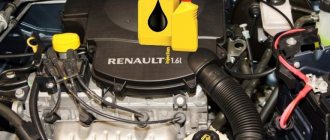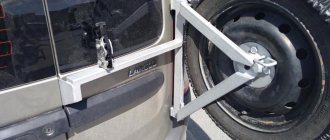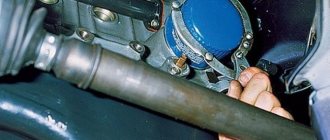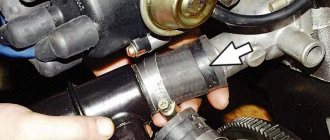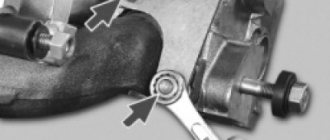For Lada Largus, it is recommended to change the engine oil every 15,000 km. or after 1 year (whichever comes first). Under severe operating conditions (large city, very dusty area), replace the oil and filter every 7-8 thousand km.
| Engine model | Engine oil volume | Factory filled oil | Recommended oils |
| K7M (8 valve) | 3.3 liters | ELF SOLARIS RNX 5W-30 | Motor oils with quality class API SL / API SM / API SN / ACEA A1/ ACEA A2/ ACEA A3/ ACEA A5 and SAE viscosity level: 15W40; 15W50 10W40; 5W30; 5W40; 5W50; 0W30; 0W40 (depending on climatic conditions). |
| K4M (16 valve) | 4.8 liters |
Instructions for changing engine oil Lada Largus (K7M and K4M)
For Lada Largus, it is recommended to change the engine oil every 15,000 km. or after 1 year (whichever comes first). Under severe operating conditions (large city, very dusty area), replace the oil and filter every 7-8 thousand km.
| Engine model | Engine oil volume | Factory filled oil | Recommended oils |
| K7M (8 valve) | 3.3 liters | ELF SOLARIS RNX 5W-30 | Motor oils with quality class API SL / API SM / API SN / ACEA A1/ ACEA A2/ ACEA A3/ ACEA A5 and SAE viscosity level: 15W40; 15W50 10W40; 5W30; 5W40; 5W50; 0W30; 0W40 (depending on climatic conditions). |
| K4M (16 valve) | 4.8 liters |
Fuel filter for Lada Lagrus
How to change the fuel filter on a Lada Largus with your own hands
The basic configuration of the Lada Lagrus involves the use of a single fuel module to purify fuel for a 1.6 MT engine. In the AvtoVAZ catalog, the electric fuel pump module for Lada Largus has the original number: 172024388R. The filter element itself is a special paper; it is not sold separately and does not have its own number. The entire electric fuel pump module is sold assembled with a fine and coarse fuel filter and it is originally expensive, as for a domestically produced car. Technical parameters are shown in the table below.
| Dimensions of fine fuel filter Lada Largus | |||||
| External diameter, mm | Length, mm | Current strength up to, A | Voltage, W | Pressure, psi | Pressure, bar |
| 134 | 198 | 4,4 | 12 | 50,75 | 3,5 |
There are analogs from cheaper manufacturers on the market.
| Manufacturer | vendor code | price, rub. |
| Henko | MV-PFA18 | 2515 |
| Ween | 192-0001 | 3851 |
The coarse fuel filter is a mesh made of polymer material in the electric fuel pump module installed in the fuel tank of the car. The coarse fuel filter is also sold assembled with an electric fuel pump module and does not have its original number. But such meshes are available for sale from different manufacturers, for example, the manufacturer Francecar offers such a mesh under the number: FCR210141. This is what Largus owners most often purchase.
When should you change?
The automaker claims that the fine fuel filter is designed for the entire service life of the car, and the service life of the Lada Largus itself, again according to AvtoVAZ, is 160 thousand kilometers, that is, we get a service life of the fine fuel filter of 160 thousand kilometers, some simply an incredible figure for any filter. One of its closest relatives, Renault Logan, has an engine life of up to 300,000 km, and the fuel filter is replaced according to maintenance every 50,000 - 60,000 km. Consequently, the conclusion suggests itself that replacing a fine fuel filter in most cases requires replacement up to 100 thousand kilometers, and a coarse filter can last no more than 35-45 thousand km. mileage Just change or clean the choice is yours.
How to drain engine oil
You will need : buy engine oil and an oil filter, prepare a “10” wrench, an “8” square wrench, a clean cloth, an empty 5 liter container. and a wire brush.
The engine oil should be drained after a trip while the engine is still warm (if necessary, warm it up to operating temperature). It is recommended to drive the car onto an overpass.
Procedure:
Under the plug there is a steel washer on the surface of which a thin layer of rubber is vulcanized. If it is damaged, replace the washer with a new one. If you do not have a new washer, you can install a copper washer with a hole diameter of 18 mm under the plug.
2163-13-05a-02
To prevent oil leakage from the crankcase pan, a thin layer of oil-resistant rubber is vulcanized along the surface of the washer hole.
To prevent oil leakage from the crankcase pan, a thin layer of oil-resistant rubber is vulcanized along the surface of the washer hole. To prevent oil leakage from the crankcase pan, a thin layer of oil-resistant rubber is vulcanized along the surface of the washer hole.
Let's examine the puck. If the rubber seal of the washer is damaged, replace the washer with a new one. Drain the oil for at least 10 minutes. We wrap and tighten the drain plug. We remove oil leaks from the engine oil pan and the power unit protection. When changing the oil, the oil filter must be replaced.
Place a container under the oil filter. Unscrew (counterclockwise) the oil filter. If this cannot be done manually...
How to replace the oil filter
You will need : a 10" or 13" wrench, a puller or a screwdriver.
On the K4M engine, access to the oil filter is blocked by the engine protection, which will have to be removed (6 x 10 screws). Or remove the fuel frame protection from above by unscrewing the 2 “13” screws. Place an empty container under the filter and turn it counterclockwise using a puller.
If you don’t have a special tool, you can use a screwdriver. For easier access to the filter on the K7M engine, you can remove the exhaust manifold thermal shield by unscrewing the three mounting screws. Then pierce the filter housing with a screwdriver (closer to the bottom of the filter, so as not to damage the motor fitting), unscrew the filter, using the screwdriver as a lever.
Fill the new filter 1/3 full with new engine oil and lubricate the sealing ring with it. Then install the oil filter, tightening it by hand until the O-ring comes into contact with the cylinder block. After this, tighten the oil filter another 3/4 turn.
Articles (must read!)
The plug is unscrewed from the bottom of the crankcase. It is supplied with a washer. These parts are not sold as a set, only individually.
Drain plug and washer
The article number of the plug is 7703075348. We were able to find three articles for the washer: 110265505R, 8200641648, 7703062062. In the latter case, it will just be a copper ring.
The washer can be made from a sheet of copper. The internal diameter should be 16.7 mm. If the dipstick is lost, it’s not a problem. Use article number 8200666287.
Selection of analogues
Firstly, the drain plug has alternative part numbers - 7703075210, 7703075347, 7903075033. Analogs for it:
- CORTECO 220100S
- BMW 07119919143
- METALCAUCHO 05655 or 00667
Show full list
- SASIC 1630210
- NISSAN 1112800Q0A or 1112800QAA
- ASAM 80102 or 30385
- CITROEN 16393 or 2221 11
- OPEL 4433916 or 4418098
- FEBI 45890
- FA1 539.970.011 or 518.471.001
The washer with a rubber band also has analogues:
- GECKO GKFLM507
- SASIC 1640540 or 4001073
- DELLO 3011020655005R
Show full list
- CITROEN 16488
- VICTORREINZ 703376900
- MANOVER MRLOGAN8853 or MRLOGAN7612
- CORTECO 006339S
- PPS 21431867
- FEBI 44793
- DT 2.10221
- AJUSA 502300
- VAICO V460562
- MERCEDES-BENZ
- SCANTECH 5321867
Filter part numbers can be found in other text.
How to fill engine oil
We pour new oil into the engine through the oil filler neck, the amount of oil in the engine is indicated in the table above. (about 0.3 liters of oil will still remain in the engine). We control the level using the oil dipstick (the oil level should be between the MIN and MAX marks).
Start the engine and let it idle for a few minutes. The emergency oil pressure indicator should go out 2-3 seconds after starting the engine. While the engine is running, check for oil leaks from under the drain plug and oil filter. Stop the engine and check the oil level; if necessary, add oil to the specified level.
The entire process of changing the Lada Largus oil is also shown in the video:
Replacement frequency, what oil to fill
According to the manufacturer's regulations, engine oil service changes are carried out after 15,000 kilometers or at intervals of 1 year. But many motorists consider this interval to be very high, recommending that it be reduced taking into account operating conditions.
At the factory, the Lada Largus model is filled with oil from different suppliers. But most often it is Lukoil Genesis Armortech 5W40 or Rosneft Maximum Service 5W-30. For more accurate information about what is poured into your car from the factory, you should contact the feedback system of PJSC AVTOVAZ. When applying, you must indicate the year and month of manufacture of the car.
If you follow the manufacturer's recommendations, then on new cars you must use Rosneft Premium 5W-40 synthetic oil. And for cars with high mileage, switch to semi-synthetic Rosneft Maximum 5W-40. By the way, about the recommendation for filling Rosneft, there is an inscription on the filler neck located on the engine.
Another option that the manufacturer supports is the official Lada Ultra 5W-40 product. It is bottled by Lukoil, and it is positioned as synthetic, although the label says “Synthetic technologies”. Because of this inconspicuous slogan, one has to wonder if it is actually synthetic?
There is a category of people who will never fill up with oil from a domestic manufacturer. Everyone has their own reasons and arguments for this. Having conducted tests among Western manufacturers, fans of this model speak very highly of Elf Evolution 900 NF 5W-40. And on cars with high mileage, Shell semi-synthetics perform well.
How much oil is in the engine lubrication system, volume table
| Model | Engine capacity | Motor marking | How many liters of oil are in the system | Original oil / factory filled |
| Lada Largus | gasoline 1.6 | K4M | 3.8 | Rosneft Premium 5W-40 / Lada Ultra 5W-40 |
| K7M | 3.3 | |||
| VAZ-21129 | 3.5 | |||
| VAZ-11189 | 3.2 |
Step-by-step instruction
Changing the oil in the VAZ 2114 engine
Changing the oil in the box is carried out on a well-warmed-up car.
Important! The temperature of the transmission fluid in the box of the Lada Largus should be 60 degrees. Determined by a special device - a scanner
If this is not the case, the car warms up to the operating temperature of the internal combustion engine. The gearbox lubricant temperature will correspond to 60 degrees. This will facilitate good oil drainage. Fig 3
It is determined by a special device - a scanner. If this is not the case, the car warms up to the operating temperature of the internal combustion engine. The gearbox lubricant temperature will correspond to 60 degrees. This will facilitate good oil drainage. Fig 3
Is it worth changing the oil in manual transmissions at all - video
The transmission oil poured into the gearbox is designed for the entire life of the vehicle and the maintenance schedule does not include operations for checking the level and changing the oil. At the same time, we recommend checking the oil level in the gearbox at every service and always when an oil leak is detected from the gearbox. We carry out the work on an inspection ditch or overpass. We check the oil level through the control (filler) hole on a cooled gearbox. The inspection hole is located on the front wall of the gearbox housing and is closed with a threaded plastic plug. We remove the power unit protection (see “Removing the power unit protection”). Use a rag to clean the gearbox housing around the inspection hole.
We unscrew the control hole plug counterclockwise. The plug is sealed with a rubber gasket. If the gasket is torn or has lost elasticity, replace it with a new one. The oil level in the gearbox should be level with the lower edge of the hole, which can be checked with your finger. If necessary, add oil of the same brand that was poured into the gearbox. A syringe for filling transmission oil...
... add oil to the gearbox to the bottom edge of the hole (oil will begin to flow out of the hole). When the excess oil has flowed out, use a rag to remove any oil spills and tighten the plug. If it is necessary to drain the oil from the gearbox (for example, when replacing the wheel drive oil seal), clean the gearbox housing around the drain hole. We place a container with a volume of at least 3.5 liters under the drain hole.
Unscrew the drain plug with a square “8”... ... and drain the oil into a container.
For sealing, a copper washer is installed under the plug. Once draining is complete, screw in the drain plug. After completing the repair work, pour oil into the gearbox through the inspection hole and tighten the plug.
Lada Largus is the best-selling Russian station wagon. Good driving characteristics, a spacious interior, high comfort and reliability - all these qualities made the car popular even on the secondary market. The simple design allows you to maintain the car yourself, and thereby save on repairs. So, during self-service, one of the most popular procedures is not only replacement, but also selection in the gearbox. Any motorist can handle this. And yet, even experienced car enthusiasts may have questions about this. In this article we will take a closer look at how to choose the right oil for a Lada Largus manual transmission.
Let's consider the criteria for choosing transmission oil for Lada Largus. The question of choosing a suitable lubricant for a manual transmission usually arises after 15-20 thousand kilometers, when it is time to change the fluid. The Russian station wagon is equipped with two types of gearboxes – JH1 (for a 1.4-liter engine) and jH3 (for a 1.6-liter engine)
. Both boxes have a certain clutch housing size, and all other characteristics are absolutely similar. But despite this fact, the two gearboxes support the same oil with identical parameters, which will be discussed later in the article.
Leaks and problems
The longer the mileage of the Lada Largus becomes, the more problems appear, as in principle with any car. Most often this is due to natural wear and tear of the engine, causing oil to burn. Although the manufacturer allows for a small consumption.
If, when inspecting the engine for leaks, they are found, then eliminating the leak, and with it the burns, is not difficult. But if there are no signs of leakage, then you should pay attention to the following nuances. Increased oil consumption can be affected by driving at high speeds, as well as frequent idling of the engine.
By the way, oil burns on 1.6 engines are quite rare. But there is one problem that is quite widespread when car owners notice oil in spark plug wells. If the car is under warranty, then we simply go to the dealer to have it fixed.
If there is no longer a guarantee, then we do the following. We take the solvent and thoroughly wipe the spark plug well. Inside the wells themselves you can find 2 small grooves; they need to be sealed with sealant. Apply the sealant to your finger and try to rub it into the grooves; remove the residue with a rag. This is a simple way to eliminate this leakage.
Source
When do you need to change the oil in a Lada Largus engine?
According to the replacement regulations from the manufacturer, it is necessary to change the oil in the Lada Largus engine every 15 thousand kilometers . However, taking into account the specifics of driving and operating conditions, this figure can be reduced to 10 thousand km.
To determine the need to change the oil, pay attention to signs of its depletion. The main indicator is the appearance: color change, the appearance of a burnt odor, impurities and sediment, and a decrease in lubricant thickness.
To detect these signs, regular preventative oil checks are necessary. During this procedure, the lubricant level is also measured using a dipstick. A situation in which the oil remains within the permissible range when heated and cooled is considered normal.
Despite the various processes that will begin with an excess or lack of lubrication in the system, the result will be the same - increased wear of engine components. Its consequence will be expensive repairs and replacement of entire units.
In this context, another set of signs are identified that indicate problems with the lubrication system. They are associated with engine malfunctions, jerking, and extraneous sounds.
Experts do not recommend waiting for such consequences to appear. Their presence indicates not only the need to change the engine oil, but also the demand for a full diagnosis of its components by specialists.
Which oil should you choose?
The question of how to choose the right oil to replace in the engine is decided by the manufacturer’s recommendations for vehicle maintenance. For filling, the best option is the original lubricant - Elf SOLARIS RNX 5W-30. The following options are suitable alternatives:
When choosing between mineral and synthetic oils, preference is given to the latter. Synthetics are more resistant to thermal and oxidative reactions, last longer and provide high-quality lubrication of working mechanisms.
Some car owners, however, prefer semi-synthetics for cars whose total mileage is more than 100 thousand km. This is due to the general wear and tear of parts and components, which can quickly become unusable due to synthetic lubricants.
Based on the viscosity of the oil, they are guided by seasonal temperature changes. The best options are 5W-30 and 5W-40, which are suitable for both frost and hot seasons.
Types of filter devices
The filter material is located inside the filter. The assembled filter is shaped like a metal glass, inside of which the filter material is installed, folded like an accordion. Its functions include allowing oil to bypass the filter if it becomes clogged and if the pressure inside exceeds the limits of the emergency valve. Its main task is to prevent a shortage of oil in the engine.
Consequently, the operating principle allows even unrefined oil to pass through if it is required for full engine operation. The insert filter is of the highest quality. Its advantage is that with higher characteristics it costs much less. The reason for this cost is that, due to its small size, it takes less time to manufacture, which does not at all affect the quality of the work.
In addition, the obvious advantages of the insert filter include a high degree of environmental friendliness during disposal and significant savings in materials required for manufacturing. The ease of replacement is also a plus. To do this, you simply need to remove the filter cover and swap the old and new elements. Thanks to the simple execution technique, a large number of low-quality fakes have appeared on the automobile market.
Therefore, when choosing a filter for Lada Largus, it is better to buy the original version from such a world-famous manufacturer as Knecht. And, of course, when determining which oil to choose, you first need to take into account the manufacturer’s advice. As a result, the machine will be used without breakdowns for a long time.
Preparing for work
Preparing to change the oil in the Lada Largus engine involves purchasing parts and components. You will also need to choose a convenient place where you will work on the car.
When purchasing, pay attention to the quality of consumables. Along with the lubricating fluid, be sure to change the filter and drain plug gasket. If necessary, other components whose wear has reached or will soon reach a critical state must also be replaced.
You should buy new parts only from trusted suppliers and official dealers. When purchasing, pay attention to compliance with the article numbers, as well as the presence of a license and quality certificates.
After acquiring all the consumables, they proceed to preparing the work site. If possible, use a viewing hole, overpass or lift. It is also permissible to use a jack and supports to evenly lift the vehicle.
The need to observe safety precautions during work is especially emphasized. For better drainage, the engine is warmed up, however, given the heating and toxicity of the oil, there is a danger of thermal and chemical burns.
In this context, the use of protective clothing and rubber gloves is relevant. In the case of self-replacement, any things that you don’t mind getting dirty will do. You will also need a container to drain the used lubricant - it is not allowed to get into the soil.
Taking into account the recommendations presented, the necessary tools and equipment for changing the oil are included in the following list:
The final stage of preparation is warming up the engine. After this step, proceed directly to the oil change procedure.
Good luck with LS-motors
The laws of physics are inexorable - during a trip, the car is affected by vibrations, pressure, heat, friction, natural factors (water, dust, sunlight), which, of course, leads to wear and deformation of parts. Even minor malfunctions have the potential to become a serious malfunction, a hazard on the road for drivers, passengers and pedestrians.
Carry out systematic maintenance of your Lada at our station - polite staff, competent mechanics, compliance of the work with regulations, quality guarantees and extended service life of your Lada Largus car await you.
Do-it-yourself oil change in the Lada Largus engine
Step-by-step instructions for changing the oil in the Lada Largus engine include the following steps:
The filter can be replaced before unscrewing the drain hole - the procedure in this matter is not critical. However, to save time, the process is carried out simultaneously with draining the used lubricant.
When it comes to filling volume, they focus on a value of 5 liters. The exact value is determined in accordance with the engine size and the manufacturer's recommendations. Some people focus on the amount of liquid drained.
The best option is to fill up to 70% of the required volume and then top up with measurements of the current level. This option allows you to avoid excess or lack of oil, but you also need to take into account possible changes after the first warm-up of the engine.
The cooling system elements are checked for preventive purposes. The procedure is optional, and taking into account the frequency of replacing antifreeze, it seems to many to be completely unnecessary. However, it allows you to detect and eliminate faults in a timely manner, ensuring high-quality and reliable engine operation.
During preventive maintenance, attention is paid to the main connections of the cooling system, checked for tightness, leaks and serviceability of fasteners. The condition of the antifreeze itself is also assessed; a significant change in color and the appearance of sediment indicates the need for replacement.
Features of changing oil in 8-valve and 16-valve engines
Changing the oil in a Largus 16 valve engine is carried out according to the same scheme as in cars with 8 valves. This is due not only to the relatedness of the assemblies, but also to the standardization of the overall process.
Engine features do not affect the choice of oil; certain differences will only be in the volume of lubricant poured. 16 valves require about 5 liters, while changing the oil in a Largus 8 valve engine requires 4 liters.
There are also nuances with the location of the filter. It is easy to recognize by its cylindrical blue casing, but access to it may be limited.
In both cases, unscrewing is done by hand. If it doesn’t work, use a special tool. However, when tightening, you should not use the same tools - tighten the casing by hand, otherwise it may burst.
K4M Renault engine: characteristics, features, malfunctions
Since 1999, the Renault concern has begun producing the K4M engine, which is perhaps the most widely used among Renault gasoline engines. Installed on Renault cars: Megane, Logan, Sandero, Kangoo, Fluence, Scenic, Clio 2, Duster, Laguna, as well as on Nissan Almera G11 and Lada Largus. This power unit was created on the basis of the previous engine - K7M, but unlike its predecessor, it received 2 lightweight camshafts (respectively, 16 valves), as well as other pistons and hydraulic compensators. The engine received its further design development on Nissan cars, for which the h5M (HR16DE) engine was created.
The K4M engine has many modifications that are clearly identified by the full engine markings (numbers and letters after the engine code). For example, the motor that we sell is labeled “Renault K4MD812 engine”. This means that the power unit is equipped with phase regulators and is equipped with a manual transmission. Some motors are not equipped with phase regulators; the compression ratio and engine firmware differ. Therefore, on the market you can find K4M engines with a range of power ratings - from 102 to 115 hp.
Features of operation and resource
The main operational disadvantage of K4M engines is the relatively short service life of the timing belt. According to the manufacturer's recommendations, routine maintenance to replace the timing belt should be carried out once every 60 thousand kilometers or once every 4 years. At the same time, the cost of the spare parts required for this procedure for a 16-valve engine is quite high. Together with the timing kit, the water pump is usually replaced, although the need to replace this unit can definitely be determined only after disassembling the gas distribution mechanism drive. An interesting feature associated with the K4M engine is that the timing belt replacement schedule for Lada Largus cars is set at 120 thousand km, although the engine itself and the components are absolutely identical. In this regard, many Lada Largus owners change the timing belt kit more often than required, and vice versa - Renault owners sometimes delay this procedure, justifying this with AvtoVAZ recommendations. In any case, it is not recommended to delay this procedure, since a broken timing belt on K4M series engines clearly leads to bending of the valves and the need for major repairs.
The frequency of replacing the timing belt is more than compensated by engine life. These power units easily exceed a mileage of 400 thousand km (of course, with proper care and light operation).
Fuel consumption is approximately 8.5 liters in the combined cycle. For the highway, this figure is 6.7 liters, which is quite a bit, but in the city, the 16-valve engine can “eat up” up to 12 liters of gasoline per 100 km. By the way, K4M “digests” Russian 92-octane gasoline without any consequences, which is why it is so popular in Russia.
Typical K4M engine problems
Some of the most common K4M engine problems include:
- The motor often stalls. This is usually associated with a malfunction of the ignition coil, injector or spark plug, but it can also mean problems with the gas distribution mechanism or piston group, so it’s worth starting the diagnosis by measuring the compression.
- floating speed. A typical malfunction is most often solved by diagnosing and replacing the ignition coil or crankshaft position sensor, or with a malfunction of the K4M phase regulator.
This is probably where the list of typical K4M engine malfunctions can end, since by and large, the engine is reliable and does not cause much trouble for the owner.
www.2chance.ru
Oil change intervals
The frequency of oil changes in the Lada Largus engine is 15 thousand km. However, when making calculations, individual factors that influence the production of lubricating fluid should be taken into account:
All this can reduce the service life of the lubricant to 10 thousand km. In this context, regular oil checking becomes recommended. Its implementation will allow us to determine the frequency of lubricant replacement at an individual level.
The consequences of untimely oil changes are related to its functionality. In addition to lubricating mechanisms, this liquid provides heat and work product removal. Increased engine overheating will be the first consequence of its expired service life.
When heated, the working parts will begin to wear out faster, which will increase sediment and impurities in the circulating fluid. This will lead to clogging of the filter and reduce its throughput, which will cause oil starvation in the main engine components.
Further consequences depend on the total mileage of the vehicle and the service life of its components. The older the parts, the faster they will begin to fail and the larger the subsequent repairs will be.
Source
Let's sum it up
High-quality oil for Largus can last for the entire declared period (15 thousand km) and maintain its conditioning properties, the main thing is to know what kind of oil to fill. If you get a low-quality product, you need to replace it as soon as possible. Be careful about the selection process, because the market is full of “high-quality” fakes in terms of colorful packaging. It is very difficult to identify such a fact, so tend to purchase lubricant from trusted and reputable sellers. Don’t skimp on oil and the 8-valve or 16-valve engine of your Lada Largus will be “happiness”!

